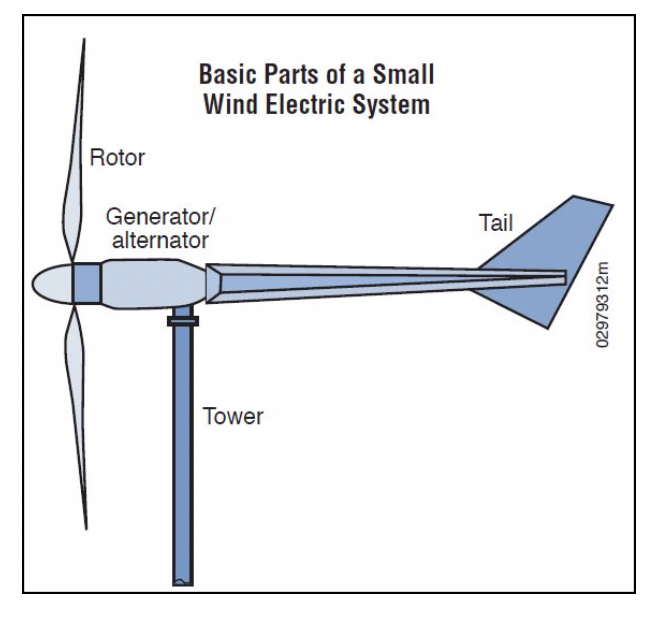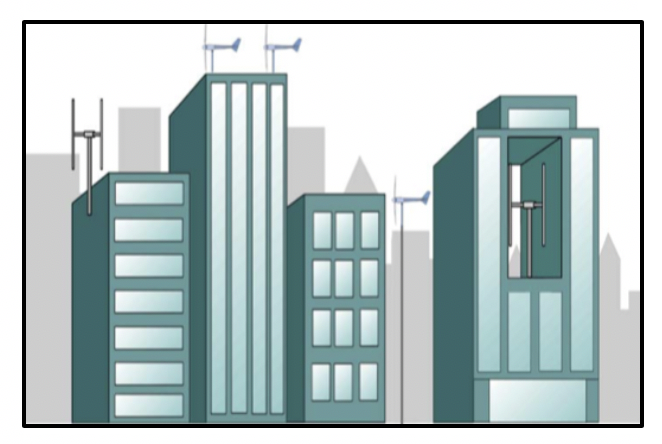On-Site Wind Energy Systems
New ResidentialWhat is an On-Site Wind Energy System?
On-site wind energy systems provide renewable energy in areas with sufficient wind speed. Prime locations for harvesting wind energy in New Jersey are along the shore.[1]
The two main types of wind turbines include horizontal axis wind turbines (HAWT), the most common, and vertical axis wind turbines (VAWT).[2] Initially designed to be mounted on high poles in open or rural areas, small wind turbines (SWTs) include systems that are 100 kilowatts (kW) or less. Small wind energy systems can either be stand-alone (e.g., not connected to the utility grid) or grid-connected. Built-environment wind turbines (BEWT) refer to projects constructed on, in, or near buildings.[3] The highly turbulent and variable wind directions often found in the built environment make VAWTs a viable option for these types of locations as VAWTs do not need to orient into the wind to generate power.[4] VAWTs come in two different designs: the Savonius design, which generates power through drag, and the Darrieus, which generates power through an aerodynamic lift.[5]

Figure 1. Small Wind Electric System (Source: US NREL).

Figure 2 – Illustration of turbine installation in the built environment. Side mounted to the building, roof mounted, ground mounted in the built environment, building integrated (source: US NREL).
How to Implement an On-Site Wind Energy System
There are many factors to consider when deciding on a wind energy system, including wind speed, location, lot size, and zoning restrictions.
Contact the NJ Office of Clean Energy to learn about current programs, tools, and available funding for on-site wind energy systems. Critical project-specific variables to consider include location, space, energy costs, available project incentives, local net metering and interconnection policies. Pre-implementation steps for an on-site wind energy system project comprise a wind resource assessment study, sizing, and design of systems. [6] For example, siting turbines on the highest elevation on the site often correspond to the highest, unobstructed wind speeds. Wind speed increases with height, and small increases in speed boost a turbine’s generating-potential significantly.[7]
Figure 3 shows that coastal New Jersey has the best wind resources, although some inland areas also have adequate winds. While wind maps help to get a general idea of the wind speeds in the area, actual wind resources on a particular site vary depending on topography and structural interference.[8]
Contact the local building authority or planning board to find out about necessary permits and requirements to build a wind energy system on the property. Zoning ordinances sometimes do not address wind turbines, or they may not allow structures taller than 35 ft. Obtaining a variance may be necessary. In January 2010, New Jersey enacted legislation to prevent municipalities from adopting regulations that place unreasonable limits or hinder the performance of small wind energy systems. For more information, visit the Database of State Incentives for Renewables & Efficient (DSIRE).
Experienced wind turbine manufacturers and installers can help to determine the potential energy production for the site, depending on wind speeds, the height of the towers, and other factors such as site elevation.[9]
Example
This study looked at several case studies of BEWTs, documenting mixed-results in the BEWT industry. Main obstacles included, 1) project feasibility and planning processes that are insufficient and not well defined, 2) additional expenses related to installation and operations in the built environment that create high-cost projects, 3) a lack of certified manufacturers for ongoing service and parts availability, and 4) over-estimated project performance due to the complexity of conducting accurate resource and production assessments in the built environment. The BEWT projects with the best outcomes had well developed and quantified project goals that included energy production as well as education and sustainability marketing goals. These projects also conducted more thorough feasibility investigations, used certified HAWTs with a proven track record, and were installed on taller buildings relative to surrounding obstacles.
Benefits
Wind power reduces dependence on carbon-intensive fuels such as coal.[10] Generating power from wind reduces greenhouse gas (GHG) emissions and promotes the renewable energy industry in New Jersey.
Costs
In New Jersey, between 2002 and 2011, residential wind turbine installation costs ranged from $12,000 to $100,000.[11] Nationwide, wind turbines cost between $800/kW and $1100/kW and a typical 2 MW project costs between $1.6 and $2.2 million.[12] Necessary fees include utility company fees, township and county permits, and installation which accounts for about 7% of the total project cost for a residential project.[13] Installing a wind turbine often have higher upfront, capital costs; however, net metering, lower utility bills, tax incentives, and renewable energy credits facilitate a faster payback and lower costs in the long run. A wind energy system can lower electricity bills 50 to 90 percent.[14] Depending on the strength of the wind resource and the cost of the system, the typical paybacks range from 6-15 years.
Resiliency
On-site wind energy systems rely on wind, a site-based resource and may operate independently from the power grid. Installed with additional hardware—including transfer switches, critical load panels, and appropriate controls—these systems can act as self-sufficient microgrids, generating energy and powering critical loads in the absence of utility sourced power. Wind energy systems provide additional protection from flooding events, based on elevated installations.
[1] American Wind Energy Association. “Wind 101: Wind Energy Basics.” https://www.awea.org/wind-power-101 (accessed April 11, 2018).
[2] WBDG. Wind Technology. https://www.wbdg.org/resources/wind-technology (accessed April 19, 2018).
[3] Jason Fields, Frank Oteri, Robert Press, and Ian Baring-Gould (2016) National Renewable Energy Laboratory. Deployment of Wind Turbines in the Built Environment: Risks, Lessons, and Recommended Practices https://www.nrel.gov/docs/fy16osti/65622.pdf (accessed April 20, 2018).
[4] J. Smith, T. Forsyth, K. Sinclair, and F. Oteri. (2015) NREL. Built-Environment Wind Turbine Roadmap. https://www.nrel.gov/docs/fy13osti/50499.pdf (accessed April 20, 2018).
[5] WBDG. Wind Technology. https://www.wbdg.org/resources/wind-technology (accessed April 19, 2018).
[6] US Dept of Energy’s (DOE) Federal Energy Management Program (FEMP). Guide to Integrating Renewable Energy in Federal Construction. https://www.wbdg.org/FFC/DOE/DOECRIT/re_construction_guide.pdf (accessed May 8, 2018).
DOE. Small Wind Guidebook. https://windexchange.energy.gov/small-wind-guidebook#parts (accessed April 11, 2018).
[8] US DOE. https://windexchange.energy.gov/maps-data/207 (accessed April 12, 2018).
[9] Ibid.
[10] McCollum, David, and Christopher Yang. 2009. “Achieving deep reductions in US transport greenhouse gas emissions: Scenario analysis and policy implications.” Energy Policy 37: 5580-5596.
[11] NJCEP. Installation and Project Status Reports (REIP and CORE Programs). http://njcleanenergy.com/renewable-energy-archive (accessed April 18, 2018).
[12] US DOE. 2016 Wind Technologies Market Report. https://www.energy.gov/sites/prod/files/2017/10/f37/2016_Wind_Technologies_Market_Report_101317.pdf (accessed April 18, 2018).
[13] Pacific Northwest National Lab. Benchmarking US Small Wind Costs. https://wind.pnnl.gov/pdf/Benchmarking_US_Small_Wind_Costs_092817_PNNL.pdf (accessed April 18, 2018).
[14] DOE. Small Wind Electric Systems. https://www.energy.gov/energysaver/buying-and-making-electricity/small-wind-electric-systems (accessed April 12, 2018).
Related Strategies
Resources
- General information and Starting Up
- NJ Clean Energy Program
- US DOE
- Technical Guidance
- US DOE
- Funding Sources
- NJ Clean Energy Program
